Before the bull market dies, the conditions are ripe for a late-market surge.
Before the bull market dies, the conditions are ripe for a late-market surge.
November 2019

Introduction
This month’s commentary was inspired by one chart. The chart (Figure 1) shows the divergence between global equities and global PMIs, a divergence which both surprises us and cuts to the heart of the debate about the economic cycle versus market pricing. Equity prices have historically been close followers, not leaders, of the direction of PMI data. With global PMIs troughing, we would be expecting a similar move in equities. The fact that this hasn’t happened begs the question: why?
One analogy that could be used is that of the tercio de banderillas – the second stage of a bullfight – where the bull is weakened with banderillas (small spears) before the matador moves in for the kill. The spears by themselves are not enough to bring down the bull; rather, it is the seismic shift to the third act, the tercio de muerte where the matador wields a sword, that ends the fight.
In a similar way, many of the concerns are not enough by themselves to bring down equity markets. We have previously detailed long-standing concerns about Brexit, the US-China trade war and European banks. To this list, we could add the exposure of the shallowness of US funding liquidity in September 2019, the reluctance of the market to fund unicorns and potential disruption in the loan market. There are more than enough banderillas in the bull market’s neck.
In our view, the single factor staying the estocada, the final thrust, is the accommodative policies of the Federal Reserve and the European Central Bank. Indeed, we would go further: since 2008, central banks have been terrified of tail risks within the financial system. The result has been over easy monetary policy, which has created a situation where it is very risky not to be invested and equity markets are almost entirely reliant on central banks. This situation was described as TINA – There is No Alternative. Our thesis is therefore simple. The bull market goes on as long as central banks do. The implication? In the short term, there is still room for equity markets to move higher. TINA is here to stay for the foreseeable future.
Figure 1. Divergence Between Global Equities and Global PMIs
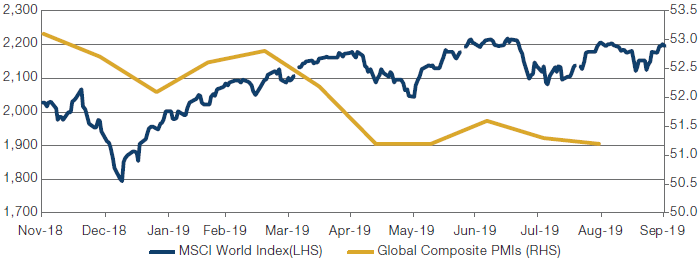
Source: Bloomberg, JP Morgan, Markit; as of 21 October 2019.
The Factors Creating a Short-Term Revival
The first and most important point in support of our argument is that the performance of the US market is closely connected to the Fed Funds Rate. As Figure 2 shows, there is a strong relationship between how accommodative monetary policy is and the performance of the US equity market (represented in this instance by the Dow Jones Industrial Average).
Recent experience endorses this argument. Between the Fed raising interest rates by 25 basis points on 26 September, 20181 and Fed Chair Jerome Powell signalling he would end the hiking cycle on 28 November, 20182, the S&P 500 Index declined 5.58%. Part of what caused this decline is that the rate hike killed TINA, if only briefly, by increasing the yield on US Treasuries. With US 10-year Treasuries hitting 3%, managers had other options than simply piling up equity risk, which contributed to the cratering of the US market. When the Fed lost its nerve, TINA was resuscitated and the market revived.
Figure 2. Fed Funds Rate Versus the Dow Jones Industrial Average
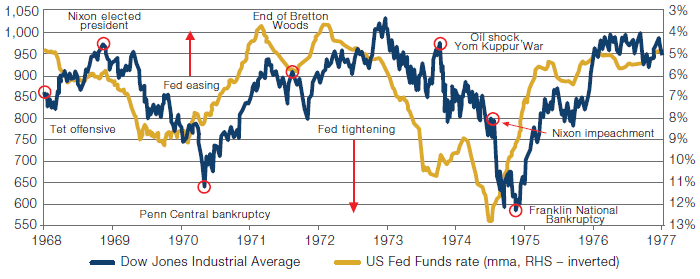
Source: BofA Merrill Lynch Global Investment Strategy, Bloomberg, Global Financial Data; as of 10 October 2019.
Equity risk premia (‘ERP’) also bolster the brighter outlook for equities. A high equity risk premium implies that the difference between the expected return to equities and the risk free rate has increased, suggesting that equities are attractive. Our analysis of ERP – which compare four types of equity yield (earnings yield, dividend yield, book value yield and cashflow yield) to inflation, bond yields and cash rates and are then turned into rolling 3-year Z scores – shows that for all four regions (the US, Europe, Japan and emerging markets), equities are cheap on a relative, historical basis (Figure 3). Indeed, our analysis shows the US to be at its cheapest since 2015.
Let’s frame the argument another way: if Greece is able to borrow at negative rates, it seems likely that equities multiples can go higher still, as compressed yields will force managers to take more risk to achieve their return requirements. As managers shift from bonds to equities, this would drive equity returns through multiple expansion. TINA and the fear of being left behind, in our view, will continue to drive equities higher over the coming months, until economic conditions change to the point where corporates and governments with a poor credit profile can no longer borrow cheaply and a recession ensues.
Figure 3. Equity Risk Premia
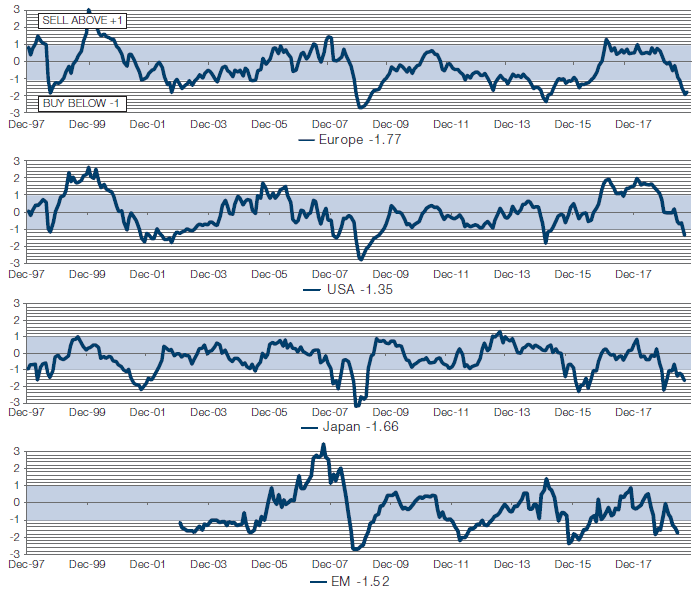
Source: Man Solutions; as of October 2019.
Additionally, there are some green shoots in the real economy. We are now seeing an increase in the growth of narrow money (M1), made up of physical currency and cash deposits. We believe this growth in M1 – which leads PMI growth by about six months – will continue over the next few months (Figure 4).
Figure 4. M1 Growth in the US, China and the Eurozone
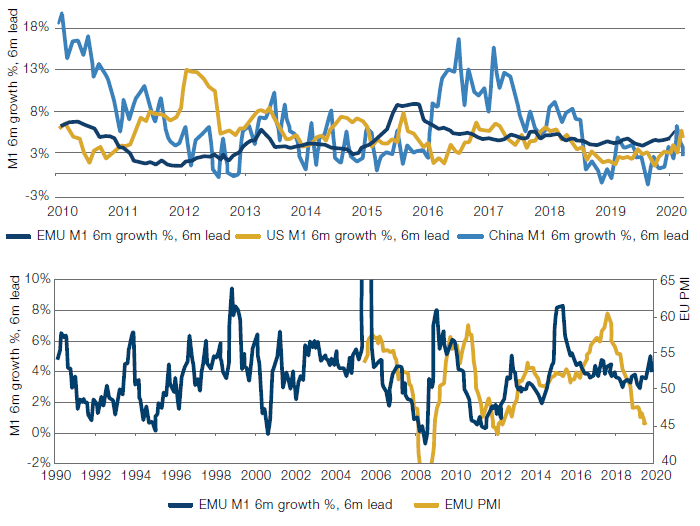
Source: Man GLG; M1 data as of 30 September 2019, PMI data as of 29 October 2019.
A further reason we believe US equity markets will continue moving higher is because the trade war put – that we identified in June – is still in operation. On 11 October, US President Donald Trump announced “phase one” of a trade deal with China, in which the US agreed to cancel tariffs due to be implemented on 15 October in exchange for the purchase of between USD40-50 billion of US agricultural products by China3. Whilst this is not quite the “epic deal” Trump once promised, it illustrates the desire from the US administration to produce tangible results in its negotiations, with the overall aim of placating Trump’s rural, red-state electoral base. Our base case remains that similar mini-deals will be used to put the trade war on hold indefinitely, which should re-assure equity markets in the near term.
The Estocada?
In fairness to the bears, there are many good reasons why they think the stock market will head lower.
As we have discussed, public markets have become unwilling to fund cash-haemorrhaging tech unicorns. Of US IPOs with an initial deal size of more than USD1 billion, four are trading lower than the offering price, with three trading at discounts of more than 30%. This figure does not include the recent failure of some firms to even reach IPO. At the same time, data from Pitchbook4 show how valuations in private markets have reached once-unthinkable levels. If this disconnect between private and public valuations persists, someone somewhere will be asked to take a big writedown. What is difficult to assess is how this affects the wider market – if big venture capital investors also own public stocks, it is reasonable to fear that they may liquidate their public holdings if forced to cover losses in their private book, which could have negative consequences for the tech sector where many of these investments are concentrated.
The 17 September liquidity squeeze in the funding markets (which revealed the fragility of the US banking system) also, counterintuitively, demonstrates the continued support the Fed is offering: to fight the sharp spike in overnight repo rates, the Fed has committed at least USD60 billion a month to buy US Treasuries5, lasting until the second quarter of 2020. Although not named as such, this will effectively function as additional quantitative easing, injecting at least USD360 billion into funding markets over the next two quarters. Whilst bears are correct to identify the spike as evidence that banks don’t have enough cash to ride out idiosyncratic funding squeezes (the spike coincided with the day that US corporations were due to pay their taxes), we believe the Fed has the tools to keep control of repo rates. There is no evidence that the Fed will become unwilling to maintain repo operations. With this in mind, another key bulwark supporting the equity market remains in place
In addition, the upcoming US election is an unappetizing prospect. National polling in the Democrat primary has former vice-president Joe Biden and Senator Elizabeth Warren as the two front-running candidates, trailed by Senator Bernie Sanders in third place (Figure 4). The latter two candidates both favour increasing the regulatory burden, expanding government spending and are perceived as being ‘market unfriendly’. President Trump remains himself, and having expended much political capital on his corporate tax cut, may have little left to offer to markets aside from bombast.
Figure 5. Summary of Six Democratic Primary Polls
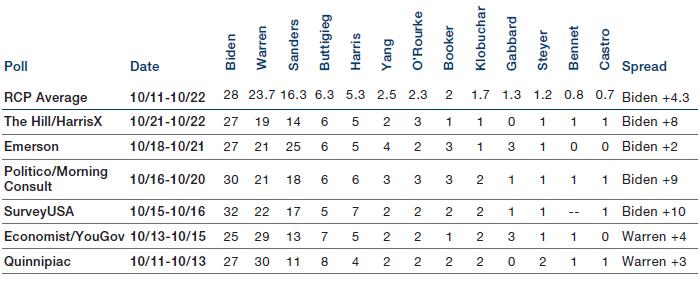
All 2020 Democratic presidential nomination polling data. Source: RealClear Politics; as of 23 October 2019.
Brexit remains an existential risk, particularly to UK and European equities. However, the re-negotiation of the Withdrawal Agreement by Prime Minister Boris Johnson, and its subsequent passage in its second reading in the House of Commons, provides some hope. This is the first Brexit agreement of any kind to pass any form of vote in the Commons, which implies that the odds of a no-deal Brexit are reducing.
Despite our thesis that market risk is contained for the moment, consensus still seems to be that we are soon heading for a recession. A survey of CFOs by Duke University showed that more than half believe that the US will be in recession by the third quarter of 2020, while two-thirds believe the US will be in recession by the end of 2020. This outlook is shared by market participants, who similarly are very bearish. Bank of America Merrill Lynch’s Bull & Bear Indicator is at its lowest level since 2016 (Figure 6). In our view, the indicator is fairly fallible: we note lower readings around 2012 and 2016, neither of which preceded a US stock market collapse.
Instead, we believe that investors are performing veronicas long after the bull has passed. Legitimate reasons to fear disruption are either not materialising (a full scale trade war, Brexit), have a delayed impact (US election) or are being contained by central banks (liquidity). We would argue that this points to a market which is vulnerable to a short squeeze. With so many managers positioned in expectation of bad news, surprises to the upside may well have an outsized effect and drive a short-term spike.
Figure 6. BAML Bull-Bear Indicator in ‘Extreme Bear’ Territory
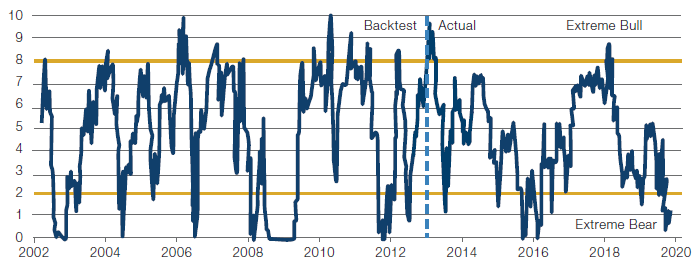
Source: BofA Merrill Lynch Global Investment strategy, EPFR Global, FMS, CFTC, MSCI; as of 10 October 2019.
However, it is worth testing our central assumption. Whilst the Fed appears to be holding the line by providing accommodative monetary policy, there is no guarantee that the ECB will continue to do the same. The latest minutes of the ECB’s monetary policy meeting indicated that a “number of members assessed the case for renewed net asset purchases as not sufficiently strong, either because they deemed them to be a less efficient instrument, given the prevailing compression of term premia, or because they deemed them to be an instrument of last resort which should only be deployed in the event of more severe contingencies and which was not warranted in the light of the current outlook”.6 The revolt was not simply confined to the usual hawks in the Bundesbank, but included the representatives of France, Germany, Austria and the Netherlands.
We feel it important to highlight the lack of unanimity on ECB’s Governing Council. The “whatever it takes” speech in 2012 and the more recent decision to override dissent to re-starting QE in the September 2019 meeting7 illustrates how former ECB president Mario Draghi had taken exceptionally firm stances on monetary policy, overriding potential opposition. Going forward, the tone of leadership may well change. The new ECB president is former lawyer Christine Lagarde, whom we would expect to be more a more consensus-oriented president, partly because by training, lawyers tend to seek compromise rather than purity. If faced with a divided MPC, we believe it more than likely that she would opt for a policy of compromise with the hawks rather than seeking to impose her own view. As such, we could well have reached the peak of accommodative monetary, with potentially dire consequences for European equity markets.
Conclusion
What, then, will finally finish the bull?
In the short-term, very little.
In our view, accommodative monetary policy will sustain the market in the short term: there is simply no appetite at either the Fed or the ECB to wield the knife. Indeed, Evercore estimates that over the next six months, the balance sheets of the Fed, ECB and BoJ will increase at an annual rate of USD1.1 trillion, while the Fed Funds Rate will likely be cut at least once. The tail-risk which this monetary policy is designed to mitigate may well not materialise. Elevated ERP will encourage a move back into equities, which combined with current bearish positioning, could cause a short squeeze. Improving M1 growth allows for possibility of a macro pickup.
Instead, the tercio de banderillas continues. We think it will be a continuance of the trends in Figure 1 that cause the end of the bull market. Without an improvement in the real economy, as captured in PMI data, the US will eventually enter recession, which will precipitate a fall in equities.
For now, the bull lives.
1. https://www.bloomberg.com/news/articles/2018-09-26/fed-raises-rates-and-says-more-coming-brushing-off-trump-jabs
2. https://www.telegraph.co.uk/business/2018/11/28/us-rate-hikes-end-soon-hints-fed-sending-shares-soaring-wall/
3. https://www.cnbc.com/2019/10/11/trump-says-us-has-come-to-a-substantial-phase-one-deal-with-china.html
4. Source: Financial Times; https://www.ft.com/content/40f66628-ebae-11e9-a240-3b065ef5fc55
5. https://www.bloomberg.com/news/articles/2019-10-11/fed-to-start-buying-60b-of-treasury-bills-a-month-from-oct-15
6. https://www.ecb.europa.eu/press/accounts/2019/html/ecb.mg191010~d8086505d0.en.html
7. https://www.bloomberg.com/news/articles/2019-09-12/draghi-faced-unprecedented-ecb-revolt-as-core-europe-resisted-qe
You are now exiting our website
Please be aware that you are now exiting the Man Institute | Man Group website. Links to our social media pages are provided only as a reference and courtesy to our users. Man Institute | Man Group has no control over such pages, does not recommend or endorse any opinions or non-Man Institute | Man Group related information or content of such sites and makes no warranties as to their content. Man Institute | Man Group assumes no liability for non Man Institute | Man Group related information contained in social media pages. Please note that the social media sites may have different terms of use, privacy and/or security policy from Man Institute | Man Group.